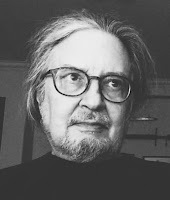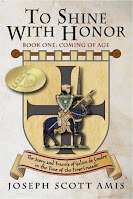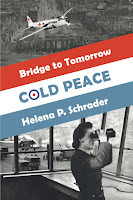Historical Figures in Historical Fiction -- A Guest Post from Scott Amis
Joseph Scott Amis retired from a thirty-year professional and business career in 2004. He has since devoted his time to medieval and Crusades studies and writing historical fiction. Until recently, Scott was a writer and features editor at Real Crusades History. A native Texan, he lives in Dallas.

To Shine with Honor, my solenovel to date, takes place in “The Times of the First Crusade” and includescharacters fictional, historical, and ‘composite’; i.e., both drawn fromthe historical record and fictionalized. The vast majority of the characters are completely fictional, so,for purposes of this essay, I’ll focus on historical and composite charactersand the means by which they were rendered for inclusion in the story. Thepurely historical include Pope Urban II, , Peter the Hermit, and Guy, Archbishop of Vienne. The composite includethe architect Joseph of Reims and his patron, Abbot Leo of the Abbé de Saint-Amand.
Regarding Urban II, beyond the five versions of the address deliveredon November 27, 1095, at Clermont, France, his noble lineage, his age at thetime, and his distinguished career in the Church, I found little to nothing inthe historical record save characteristically stylized illustrations executed‘after the fact’, that hints at his appearance, demeanor, and personality. As aresult, ‘re-inventing’ him for his one appearance in To Shine with Honorbecame a necessity.
Reconstructing a person of lesser importance would be a simpletask, but lending character to the Pope whose commanding address initiated thebeginning of the First Crusade and would inform the climactic scene in called for careful attentionand a bit of ‘reverse engineering’.
An orator capable of composing and delivering an address that receivedimmediate responses and commitments much greater than Church powers expected, andwould eventually motivate a hundred thousand noblemen, knights, and ordinarypeople to ‘take the Cross’, would have been of necessity a man of extraordinarypresence, vigor, and confidence, as well as humility and empathy; all of thesedespite Urban’s age, fifty-four years; still young in the twenty-first century;approaching old age in the eleventh. Using these assumptions along with theavailable historical sources, as well as an appropriate touch of ‘literary license’,I was able to construct an effective Urban who was well-received by reviewersand critics. Of the extant accounts of Urban’s address, I chose that written byRobert the Monk as the basis of the semi-fictional version recounted in . Robert’s narrative providedboth drama and detail sufficient for story purposes.
Peter the Hermit was the most famed - and certainly the mostcolorful - of the itinerant friars and monks who wandered throughout Francepreaching Urban’s promise of remission of sin and entry into the Kingdom of Godfor those who fulfilled their pilgrim’s vow or died along the way. The readilyavailable English translations of contemporary accounts - William of Tyre’s AHistory of Deeds Done Beyond the Sea and The Version of Guibert ofNogent - provided descriptions more than ample for the scene in which heappears in .
In writing Historical Fiction, historical persons who serve as minor“walk-on” characters require careful research and characterization, even iftheir appearance in the story is brief and seemingly unimportant. Two notable examplesappear in To Shine with Honor: Bishop Adhémar of le Puy and Guy,Archbishop of Vienne. , present at Clermont as personal aide to Urban, makes a briefappearance as the first person to publicly take the Cross from Urban; after, ashe gives the Cross and vow to the fictional knight de Coudre. A brief description ofAdhémar’s clerical attire and his words spoken to Thierré proved sufficient tocomplete the scene.
Guy of Burgundy had an eminent career in the Church, concludingwith his election as Pope Callixtus II in 1119. Guy, who appears in To Shinewith Honor in 1093, had been newly appointed to the Archbishopric of Vienneand was heir to the task of resuming work on the historical Cathedral ofVienne. In To Shine with Honor, Guy contracts with the fictional Martin deCoudre and Roger de Lyon for stone sufficient for completion of his cathedral. SinceGuy was barely past twenty years old when elevated to Archbishop - a promotionfitting for sons of highest nobility who entered the Church - and he is morethan satisfied with the terms of the contract, I portrayed him as friendly,affable, and a bit unaware of his own importance.
The fictional Abbé de Saint-Amand of , conceptually based on the famed Monastery of St. Gall,is named after Saint Amand, a Frankish missionary bishop who lived in the sixthand seventh centuries. Amand is a patron saint of wine and beer makers; thefictional monastery named so for the reason that its principal products arewine and ale. This location also serves as the setting for the account ofthe fictional architect Joseph of Reims and his role as the originator of ‘Gothic’architecture.
The historical precedent for the great Gothic cathedrals of Europeis the reconstruction of the Abbey Church of Saint Denis, located north ofmedieval Paris, under the patronage of the visionary Abbot Suger. Thiswork began in 1135 and was completed in 1144; unfortunately, the name of thearchitect who worked closely with Suger has been lost.
Those familiar with the historical development of Gothicarchitecture - originally and correctly, le style français - willrecognize Abbot Leo as a fictional portrayal of Abbot Suger, whose many notableaccomplishments include the redesign and reconstruction of the Abbey Church ofSaint-Denis; Joseph of Reims, as the author’s characterization of the unknownarchitect who worked closely with Suger to bring this significantly influentialproject to completion. My own adaptation of the historical account: geographical relocationand transplantation into the late eleventh century, the recreation of Suger andhis unknown collaborator in the composite characters of Joseph and Leo, and thereconstruction of the church at the Abbé de Saint-Amand, represents thegreatest amount of ‘literary license’ taken in To Shine with Honor.
+ + +
Nearly nine years after the publication of To Shine with Honor,I find myself still on the fence between two partially written sequels: thefirst, a continuation of the adventures of protagonist Galien de Coudre as hejourneys to the Holy Land, serves as a knight in the First Crusade, and remainsin the new Kingdom of Jerusalem until his death in 1125; the second‘fast-forwards’ fifty years to the eighth decade of the twelfth century and thestory of Roger de Coudre, great-grandson of Galien, during the reign of KingBaldwin IV; subsequently, under the command of over the course of the Third Crusade.
Either sequel will present its own challenges - in the first, as Ienvision and plan close and extended interaction between Galien and his brotherThierre with the temperamental leader Bohemond of Taranto; in the second, Rogerde Coudre with King Baldwin IV; after Baldwin’s early death and the fall ofJerusalem to Saladin, with Richard Couer de Lion.
Any difficulties encountered while creating composite characters ofthese medieval heroes won’t be from a lack of sources; primary, secondary, orfictional. Extensive records of Richard I exist from the renowned warriorking’s own time, he has been the subject of countless academic studies and publications,and seemingly equally numerous novels, movies, and video games. Though Bohemond and Baldwin have been much lesswell-known, sufficient original and academic sources are readily available, and,with renewed interest in the medieval Crusades, both have found their way into thepublic media. Baldwin, by way of a flawed yet memorable appearance in thecinematic epic Kingdom of Heaven, has been propelled fromacademic obscurity to popular folk hero and inclusion, with varying degrees of ation, in more than a few recent novels andvideo games.
As a result, the problems I’m certain to encounter in the courseof developing compelling characters, particularly Baldwin, won’t come from alack of source materials; rather, from an overabundance of these and the needfor creative originality when .
In comparison with Baldwin, Bohemond should prove much easier to render- to my knowledge, extensively characterized fictional versions of him are farless numerous than of Baldwin. Anna Comnena, daughter of Byzantine Emperor AlexiusI and an impressionable teenager at the time of the First Crusade, unknowinglydid future historians and novelists a great favor with her comprehensive and colorful- some claim admiring - description of Bohemond in her classic memoir, TheAlexiad.
Richard Couer de Lion ‘it’s all been done before’, so much so thatcreating a truly original version of him could also arguably be a textbook caseof ‘why bother?’ - just be careful not to blatantly plagiarize in the process.
As in all Historical Fiction, To Shine with Honor is set ina ‘master framework’ of historical places, persons, and events. However, creationof the environment and characters, be they fictional or composite, necessitatesa degree of period accuracy equal to those verifiably historical.

Find out more about To Shine with Honor at: here.
Blog Host, Helena P. Schrader, is the author of
the Bridge to Tomorrow Trilogy.
The first two volumes are available now, the third Volume will be released later this year.

The first battle of the Cold War is about to begin....
Berlin 1948. In the ruins ofHitler’s capital, former RAF officers, a woman pilot, and the victim of Russianbrutality form an air ambulance company. But the West is on a collision coursewith Stalin’s aggression and Berlin is about to become a flashpoint. World WarThree is only a misstep away. Buy Now
Berlin is under siege. More than twomillion civilians must be supplied by air -- or surrender to Stalin's oppression.
USAF Captain J.B. Baronowsky and RAF FlightLieutenant Kit Moran once risked their lives to drop high explosives on Berlin.They are about to deliver milk, flour and children’s shoes instead. Meanwhile,two women pilots are flying an air ambulance that carries malnourished andabandoned children to freedom in the West. Until General Winter deploys on theside of Russia. Buy now!
Based on historical events, award-winning and best-selling novelistHelena P. Schrader delivers an insightful, exciting and moving tale about howformer enemies became friends in the face of Russian aggression — and how closethe Berlin Airlift came to failing.
Winning a war with milk, coal and candy!



